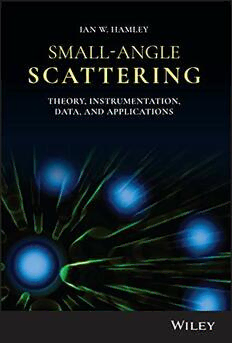
Small-Angle Scattering: Theory, Instrumentation, Data, and Applications PDF
Preview Small-Angle Scattering: Theory, Instrumentation, Data, and Applications
(cid:2) Small-Angle Scattering (cid:2) (cid:2) (cid:2) (cid:2) Professor Ian Hamley’s Book Publications Authored ThePhysicsofBlockCopolymers IntroductiontoSoftMatter(firstandrevisededition) BlockCopolymersinSolution IntroductiontoPeptideScience Edited DevelopmentsinBlockCopolymerScienceandTechnology NanoscaleScienceandTechnology(withR.W.KelsallandM.Geoghegan) HydrogelsinCell-BasedTherapies(withC.Connon) (cid:2) (cid:2) (cid:2) (cid:2) Small-Angle Scattering Theory, Instrumentation, Data, and Applications IAN W. HAMLEY SchoolofChemistry,UniversityofReading,UK (cid:2) (cid:2) (cid:2) (cid:2) Thiseditionfirstpublished2021 ©2021JohnWiley&SonsLtd Allrightsreserved.Nopartofthispublicationmaybereproduced,storedinaretrievalsystem,or transmitted,inanyformorbyanymeans,electronic,mechanical,photocopying,recordingorotherwise, exceptaspermittedbylaw.Adviceonhowtoobtainpermissiontoreusematerialfromthistitleisavailable athttp://www.wiley.com/go/permissions. TherightofIanW.Hamleytobeidentifiedastheauthorofthisworkhasbeenassertedinaccordance withlaw. RegisteredOffices JohnWiley&Sons,Inc.,111RiverStreet,Hoboken,NJ07030,USA JohnWiley&SonsLtd,TheAtrium,SouthernGate,Chichester,WestSussex,PO198SQ,UK EditorialOffice TheAtrium,SouthernGate,Chichester,WestSussex,PO198SQ,UK Fordetailsofourglobaleditorialoffices,customerservices,andmoreinformationaboutWileyproducts visitusatwww.wiley.com. Wileyalsopublishesitsbooksinavarietyofelectronicformatsandbyprint-on-demand.Somecontentthat appearsinstandardprintversionsofthisbookmaynotbeavailableinotherformats. LimitofLiability/DisclaimerofWarranty Inviewofongoingresearch,equipmentmodifications,changesingovernmentalregulations,andthe constantflowofinformationrelatingtotheuseofexperimentalreagents,equipment,anddevices,the readerisurgedtoreviewandevaluatetheinformationprovidedinthepackageinsertorinstructionsfor eachchemical,pieceofequipment,reagent,ordevicefor,amongotherthings,anychangesinthe instructionsorindicationofusageandforaddedwarningsandprecautions.Whilethepublisherand authorshaveusedtheirbesteffortsinpreparingthiswork,theymakenorepresentationsorwarrantieswith respecttotheaccuracyorcompletenessofthecontentsofthisworkandspecificallydisclaimallwarranties, (cid:2) includingwithoutlimitationanyimpliedwarrantiesofmerchantabilityorfitnessforaparticularpurpose. (cid:2) Nowarrantymaybecreatedorextendedbysalesrepresentatives,writtensalesmaterialsorpromotional statementsforthiswork.Thefactthatanorganization,website,orproductisreferredtointhisworkasa citationand/orpotentialsourceoffurtherinformationdoesnotmeanthatthepublisherandauthors endorsetheinformationorservicestheorganization,website,orproductmayprovideorrecommendations itmaymake.Thisworkissoldwiththeunderstandingthatthepublisherisnotengagedinrendering professionalservices.Theadviceandstrategiescontainedhereinmaynotbesuitableforyoursituation. Youshouldconsultwithaspecialistwhereappropriate.Further,readersshouldbeawarethatwebsites listedinthisworkmayhavechangedordisappearedbetweenwhenthisworkwaswrittenandwhenitis read.Neitherthepublishernorauthorsshallbeliableforanylossofprofitoranyothercommercial damages,includingbutnotlimitedtospecial,incidental,consequential,orotherdamages. LibraryofCongressCataloging-in-PublicationData Name:Hamley,IanW.,author. Title:Small-anglescattering:theory,instrumentation,dataand applications/IanW.Hamley. Description:Firstedition.|Hoboken,NJ:Wiley,2021.|Includes bibliographicalreferencesandindex. Identifiers:LCCN2020043351(print)|LCCN2020043352(ebook)|ISBN 9781119768302(hardback)|ISBN9781119768333(adobepdf)|ISBN 9781119768340(epub) Subjects:LCSH:Small-anglescattering. Classification:LCCQC482.H3652021(print)|LCCQC482(ebook)|DDC 537.5/3–dc23 LCrecordavailableathttps://lccn.loc.gov/2020043351 LCebookrecordavailableathttps://lccn.loc.gov/2020043352 CoverDesign:Wiley CoverImage:GiroScience/AlamyStockPhoto Setin10/13ptSabonLTStdbySPiGlobal,Chennai,India 10 9 8 7 6 5 4 3 2 1 (cid:2) (cid:2) Contents Preface ix 1 BasicTheory 1 1.1 Introduction 1 1.2 WavenumberandScatteringAmplitude 2 1.3 IntensityforAnisotropicandIsotropicSystemsand RelationshipstoPairDistanceDistributionand (cid:2) (cid:2) AutocorrelationFunctions 3 1.4 GuinierApproximation 7 1.5 FormandStructureFactors 8 1.6 StructureFactors 11 1.7 FormFactors 26 1.8 FormandStructureFactorsforPolymers 36 References 41 2 DataAnalysis 45 2.1 Introduction 45 2.2 Pre-MeasurementSampleConcentrationand PolydispersityMeasurements 46 2.3 Overview:DataReductionPipeline 46 2.4 CorrectionsforSampleTransmissionandOthers 48 2.5 BackgroundCorrections 49 2.6 DetectorCorrections,MaskFiles,andIntegration 51 2.7 AnisotropicData 54 2.8 CalibrationofqScale 54 2.9 AbsoluteIntensityCalibration 56 2.10 Absorption 58 2.11 SmearingEffects 59 2.12 SolutionSAXSDataChecks 60 (cid:2) (cid:2) vi CONTENTS 2.13 PorodRegime 67 2.14 KratkyPlots 68 2.15 ZimmPlots 70 2.16 InvariantandRelatedInformationContentFromSAS Measurements 72 2.17 FormFactorFitting 73 2.18 SASSoftware 80 References 80 3 InstrumentationforSAXSandSANS 87 3.1 Introduction 87 3.2 SynchrotronFacilities 88 3.3 NeutronScatteringFacilities 88 3.4 SynchrotronSAXSInstrumentation 91 3.5 LaboratorySAXSInstrumentation 99 3.6 SANSInstrumentation 101 3.7 Ultra-Small-AngleScatteringInstruments 104 3.8 StandardSampleEnvironments–SAXS 106 3.9 StandardSampleEnvironments–SANS 109 (cid:2) 3.10 StandardSampleEnvironments–GISAS 109 (cid:2) 3.11 MicrofocusSAXSandWAXS 110 3.12 SpecializedSampleEnvironments 111 References 127 4 ApplicationsandSpecificsofSAXS 137 4.1 Introduction 137 4.2 ProductionofX-Rays 139 4.3 ScatteringProcessesforX-Rays 142 4.4 AtomicScatteringFactors 144 4.5 AnomalousSAXSandSAXSContrastVariation 145 4.6 BioSAXS:SolutionSAXSfromBiomacromolecules, EspeciallyProteins 147 4.7 SolutionSAXSfromMulti-DomainandFlexible Macromolecules 154 4.8 SolutionSAXSfromMulti-Component Systems–BiomolecularAssemblies 160 4.9 ProteinStructureFactorSAXS 161 4.10 SAXS(andWAXS)StudiesofSoftMatterSystems 163 4.11 SAXSandWAXSFromSemicrystallinePolymers 164 4.12 LipidPhases:ElectronDensityProfileReconstruction 168 4.13 SAXSStudiesofPeptideandLipopeptideAssemblies 171 (cid:2) (cid:2) CONTENTS vii 4.14 SAXSStudiesoftheStructureFactorofColloids 173 4.15 SAXSandSAXS/WAXSStudiesofBiomaterials 177 4.16 FastTime-ResolvedSAXS 182 References 187 5 ApplicationsandSpecificsofSANS 197 5.1 Introduction 197 5.2 ProductionofNeutrons 198 5.3 DifferentialScatteringCross-Section 199 5.4 ScatteringLengths 200 5.5 SANSDataReductionConsiderations 202 5.6 ContrastVariation 203 5.7 SingleMoleculeScatteringfromMixturesofProtonated andDeuteratedMolecules 215 5.8 SANSfromLabelledPolymers 217 5.9 KineticSANSUsingLabelledMixtures 222 5.10 Ultra-Small-AngleSans(USANS) 223 5.11 SANSandUSANS(ANDSAXSandUSAXS)Studieson PorousStructures 224 5.12 SANSonMagneticMaterials 227 (cid:2) (cid:2) 5.13 Spin-EchoSANS(SESANS) 232 5.14 ComplementarySAXSANDSANS 233 References 233 6 Grazing-IncidenceSmall-AngleScattering 241 6.1 Introduction 241 6.2 BasicQuantities:DefinitionofAngles,RefractiveIndex, andScatteringLengthDensity 242 6.3 CharacteristicScans 245 6.4 TheDistortedWaveBornApproximation 252 6.5 DataAnalysis 256 6.6 ExperimentalExamplesofGISASData 257 6.7 ExperimentalExamplesofGIWAXS/GIXDData 265 References 269 Index 273 (cid:2) (cid:2) Preface This book aims to provide an up-to-date and comprehensive account of small-anglescattering,bothsmall-anglex-rayandsmall-angleneutronscat- tering. It discusses both the underlying theory as well as giving practical informationandusefulexamples.Thebookaimstocomplementthehandful ofexistingtextsinthefieldbuthasabroadercoverage,notbeingrestricted solely to biological macromolecules or polymers or soft matter. The text is intendedtoservetwouses.First,itisa‘go-to’referencetextasasourceof (cid:2) detailed information and essential references for those already working in (cid:2) thefield.Second,itshouldserveasausefulgeneralintroductiontothefield forthenon-expert.Thewritingofthistextreliesonmorethan30yearsof experienceworkingacrossthefieldonmanysystemsandinnumeroustypes ofsmall-anglescatteringexperiment,leadingteamsusingmanyinstruments acrossmostmajorEuropeanfacilities,aswellaslabinstruments. IthanktheSynchrotronRadiationSource,Daresbury,forhostingmeasa visitingfellowin2004andDiamondLightSourceforthejointappointment (withtheUniversityofReading)2005–2010.IwouldliketothankmyPhD supervisors (back in the mists of time) at the University of Southampton, Prof.GeoffreyLuckhurstandProf.JohnSeddon,forintroducingmetothe world of small-angle scattering. I would like to thank many people with whom I have worked at synchrotron and neutron facilities over the years. Thefollowingisanincompletelist(sorryforomissions): At Risø: Jan Skov Pedersen, Kell Mortensen, Martin Vigild, Wim de Jeu (AMOLF, The Netherlands) and Frank Bates (University of Minnesota, USA),andJanatAarhusaswellandFrankatNISTalso.AtSRSDaresbury: Anthony Gleeson, Günter Grossmann, Ernie (Bernd) Komanschek, Liz Towns-Andrews, Chris Martin, Wim Bras, Tony Ryan, Greg Diakun and Nick Terrill, and many members of my group when at the University of Leeds, especially John Pople and Patrick Fairclough and Tim Lodge (UniversityofMinnesota)forSAS-relatedcollaboration.AtISIS:SteveKing, (cid:2) (cid:2) x PREFACE Richard Heenan, Sarah Rogers, Ann Terry, and James Doutch. At LURE: Claudie Bourgaux. At LPS Université Paris-sud: Marianne Imperor-Clerc and Patrick Davidson. At ELETTRA: Heinz Amenitsch. At LLB: Laurence Noirez.AtMLZ,Munich:HenrichFrielinghausandatOakRidgeNational Lab: Bill Hamilton and George Wignall. At the ESRF: Olivier Diat, Pierre Panine, Narayan (Theyencheri Narayanan), Kristina Kvashnina, Daniel Hermida-Merino, Giuseppe Portale, Petra Pernot, Martha Brennich, Mark Tully, Adam Round, Gemma Newby, and Tom Arnold. At DESY: Sergio Funari and Dmitri Svergun. At the ILL: Peter Lindner and Lionel Porcar. At MaxLab: Tomás Plivelic and at PSI-Swiss Neutron Source: Joachim Kohlbrecher. At ALBA: Marc Malfois and at SOLEIL: Javier Perez. At Diamond: Nick Terrill, Katsuaki Inoue, Nathan Cowieson, Nikul Khunti, Charlotte Edwards-Gayle, and Rob Rambo. I would also like to especially thank Narayanan Theyencheri (Narayan) from the ESRF for a critical reading and valuable comments on the text. As usual, I take responsibility foranyremainingerrorsandomissions.BiggestthanksgotoValeriaCastel- letto,whohasbeenateammember/leaderatmanybeamtimesessions–and (perhaps more importantly!) we have also shared our lives for the last 20 years,‘anditdoesn’tseemadaytoolong’. (cid:2) (cid:2) IanW.Hamley UniversityofReading,UK,2020 (cid:2) (cid:2) 1 Basic Theory 1.1 INTRODUCTION Small-angle scattering (SAS) is an important technique in the characteri- zation of the structure and order in nanostructured materials as well as biomolecules and other solutions and suspensions. This book covers both small-anglex-rayscattering(SAXS,thesubjectofChapter4)andsmall-angle neutron scattering (SANS, discussed in Chapter 5) as well as grazing inci- (cid:2) dencesmall-anglescattering(GISAS,Chapter6).Thisbookdoesnotdiscuss (cid:2) small-anglelightscattering(alsoknownasstaticlightscattering,SLS),which isaseparatetopic.Althoughtherearemanysimilaritiesinthetheory,light scatteringisthesubjectofmanyspecialisttexts[1,2],aswellaschaptersin texts about general SAS [3, 4]. This book also includes in Chapters 3 and 4discussionofwide-anglescattering,especiallywide-anglex-rayscattering (WAXS), which can be performed along with SAXS in the characterization ofcertainnanomaterialsincludingpolymersandnanoparticlesystemswith crystal or partially crystalline ordering. Instrumentation for the different typesofmeasurementisdiscussedinChapter3anddataanalysisprocesses arediscussedinChapter2. SAS, by the nature of reciprocal space, is suited to probe structures with sizes in the approximate range 1–100nm, which is the structural size scale corresponding to many types of soft and hard nanomaterial as well as biomolecules such as proteins in solution. Considering Bragg’s law, the scattering from such large structures will be observed at small angles (less thanafewdegreesofscatteringangle2𝜃).Wide-anglescatteringcoversthe 0.1–1nm range. Ultra-small-angle scattering (USAXS and USANS), also Small-AngleScattering:Theory,Instrumentation,DataandApplications, FirstEdition.IanW.Hamley. ©2021JohnWiley&SonsLtd.Published2021byJohnWiley&SonsLtd. (cid:2)
